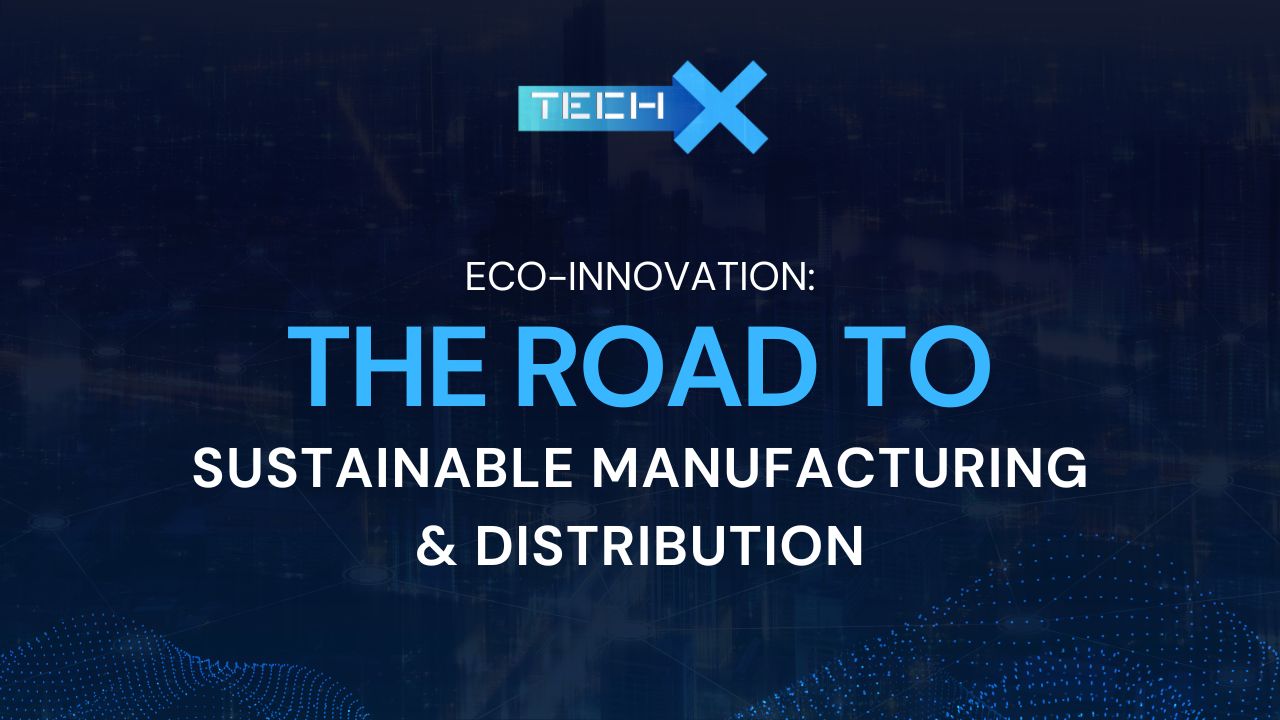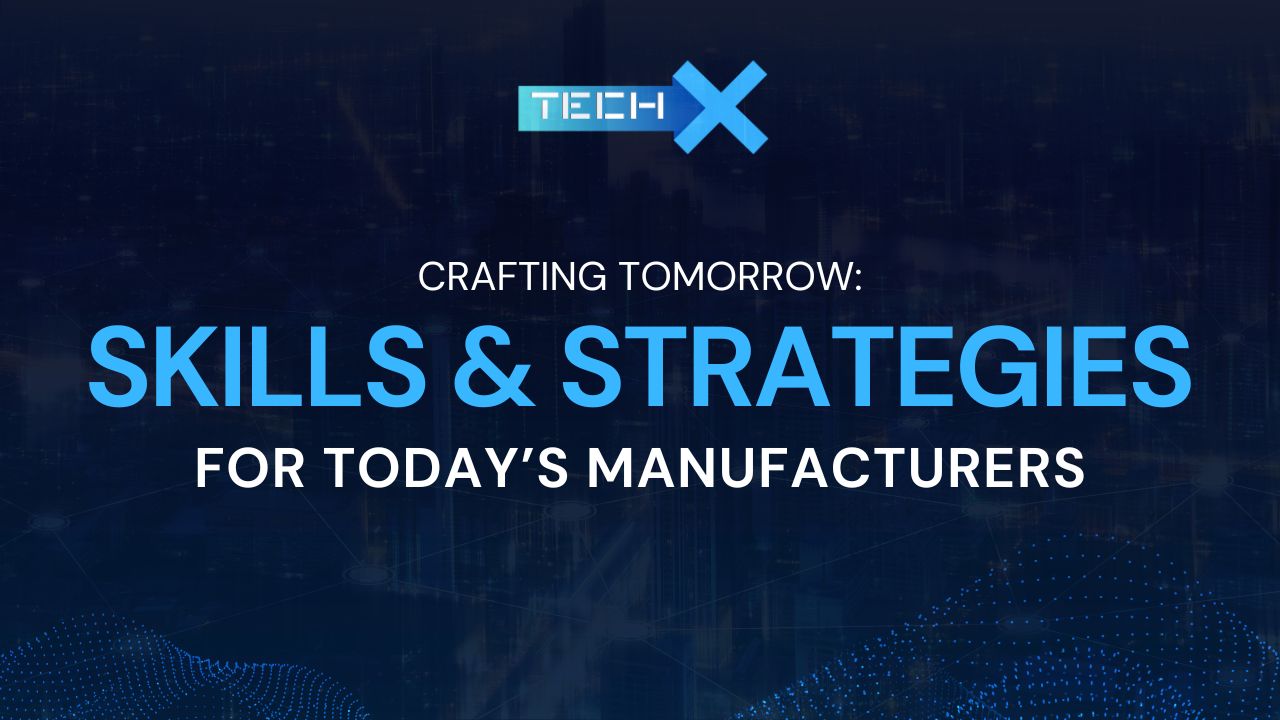Show Notes
In this insightful episode of the TechX Podcast, Merritt DeGraw, Chief Technology Officer at Fortuna is joined once again by Seth Waters, to wrap up their comprehensive discussion on the evolution of manufacturing and distribution through technology. They delve into the critical topics of efficiency and sustainability, exploring innovative strategies companies are adopting to enhance eco-friendly practices and optimize supply chain efficiency, while also underscoring the critical role of technology in shaping more efficient, sustainable, and resilient supply chains. Merritt shares his insights on the significant impact of global events on supply chain management. Join us as we uncover the future of manufacturing and distribution, highlighting the importance of flexibility, vendor management, and the transformative power of technology.
Topics Discussed
- Sustainability in manufacturing and distribution
- Understanding the ecological impact of products from creation to market
- Recent trends in reporting operational impacts to boards and public shareholders
- The importance of risk assessment and management in a distributed and on-demand supply model.
- The role of IT consulting and staffing in navigating data security challenges.
- Fortuna’s approach to partnering with companies for technological solutions.
- The significance of vendor accountability and the ability to adapt to changes quickly.
Quotes
It’s about being able to pivot… understanding those pain points and building a plan to navigate out of those challenges.
Merritt DeGraw
Understanding your business and where you want to go is crucial… ask hard questions of your vendors.
Merritt DeGraw
Nobody’s perfect… people succeed or organizations succeed that are able to pivot in bad markets or bad times.
Merritt DeGraw
Transcript:
Seth Waters: Well, welcome back to the TechX podcast. I’m Seth Waters. I’m the Chief Marketing Officer at Fortuna, and I’m here with Merritt DeGraw, the Chief Technology Officer at Fortuna, as well as Planned Capacity and a bunch of other companies that you work with all over the board. Yes, in our last couple of conversations together, we dove into this topic on where technology is intersecting with manufacturing and distribution. And we’ve talked about a lot of different things like the rise of automation and AI and how leaders in the industry can begin to think about upskilling their employees and adopting new practices, finding the right guides to lead them through the challenges that they’re that they’re facing. It’s been really valuable. And by the way, thank you for your emails. They’ve been reaching out to us. Always feel free to send us an email if you hear something that we’re talking about and you say, “Boy, I’d like to know a little bit more about that, or I’d like to connect with Merritt or Seth and find out more about Fortuna and what they do.” You can always send us an email to techx@fortunabmc.com. Today, as we dive into the final part of this conversation about manufacturing and distribution, I’d love to jump in and talk about efficiency and sustainability.
These are two hot topics for everyone, right? Is there talk about technology and all of the things in the future? Merritt, what steps do you see companies taking towards sustainability and eco-friendly practices in manufacturing and distribution?
Merritt DeGraw: Why? There’s a big push in that direction today to understand how your products are made, how they get shipped, how are they kind of impacting the global ecosystem? I think is one of the big conversations. So, you know, again, I think a lot of it is the ability to, one, measure how your operations are impacting, right? I think you’re starting to see a lot of that coming out today.
And then again, tracking that from a perspective as it as your product moves to market, kind of giving that scorecard, right? If you look at it, a lot of that information now goes at the boards. It goes up to public shareholder meetings, you name it. Those are all elements that are touched in those areas, right? So being able to put the key metrics in place to be able to facilitate that conversation kind of sets you apart nowadays for some that are not quite there yet in terms of, you know, they may not have a big of a public presence maybe on the distribution side. Yeah, but as you can see, a lot of the big players are all having to touch those spaces, even on the Bitcoin side right now where, you know, you have to talk about how you basically have to publish how much power you’re using today, right? So that’s those are all elements that are just recently come into play. So one is, you know, how do you measure it? How you how do you manage it right from that perspective to ensure that you’re bringing a key. What is the word? I want to use an ethical product to market that probably the best way to say it, right?
Seth Waters: That’s beautiful. You know as on this topic, what strategies do you see being used to optimize supply chain efficiency these days?
Merritt DeGraw: I see some of the innovators today are using blockchain technologies, right? I think if you look at IBM, you look at a few of the others that are out there, they’re using blockchain to be able to validate kind of how the products are produced. So they’re again tying newer technologies in because ultimately what a blockchain is, is a distributed ledger, right? So it’s basically saying, “Hey, here’s what happened, here’s the transaction, here’s how it went,” right? And again, that efficacy is, is there visible to all and validated from a third kind of- a third validator, right? Which is kind of I’m trying to think of the easiest way to say it so people understand it. But ultimately, it’s a lack of a centralized authority to be able to validate it, which I think is the key to a blockchain technology, right? Is that it’s there’s no one controls it. You again you can’t fudge the numbers. it is what it is. It’s what’s on there. There’s some challenges there. But again, I think for the most part, you know, the technologies that are that are getting created right now are being able to help fill some of those conversation. That’s right.
Seth Waters: That’s good. And, you know, there’s a lot going on globally right now and different things around the world that are taking place, that are impacting a lot of things locally. How do global events impact supply chain management?
Merritt DeGraw: Well, look at what happened during COVID. I mean, a ship gets stuck in the Suez Canal, right, caused massive backups and shortages around all areas, right? So, whether it be Cisco with their products, you know, their Cisco, their switching markets or their or their hardware, right? And that’s not being able to available for you to deploy, right?
A lot of change happening in a short period of time. So COVID kind of unearthed a challenge or a pain point that, again, I don’t think a lot of people put a lot of risk behind, right? They didn’t say it was a high risk in type of environment. So, again, I think there’s a couple of those two scenarios in particular kind of shining a light on the risk that’s actually there as part of this distributed model, right? On-demand model, right?
Seth Waters: You know, and we talked in our last episode around data security, right? And protecting what we have and how important it is to have guides in the conversation with you. And if you’re looking for a solution, by the way, that’s part of what Merritt leads at Fortuna. Fortuna is an IT consulting staffing company, and we would love to talk with you about how we can bring our solutions to serve your company in both the data security areas and other emerging technology conversations.
Let’s just do something fun and put you in the client perspective. As a client, what do you value most, manufacturing or distribution partner? This is a fun thing for those leaders that are watching this and are wanting to get some insight from the client side. What are some things that you value most?
Merritt DeGraw: That’s a tough one. The ability for my vendors to be flexible, right? From a manufacturing perspective, we’re jumping into the space. So ultimately, it’s, you know, things change and we all know it. But being able to like, say, for instance, if I have a supplier that has, you know, it makes it hard for me to connect with them, to be able to place orders with them, to be able to see how I’m performing against it. So really, it’s that- a customer, one that I, I value vendors that are able to be easy to work with, if that makes sense, right?
Seth Waters: Yes.
Merritt DeGraw: I mean, it’s I kind of went around that a little bit, but I think for the most part it’s they’ve got to be able- and I said flexible, but ultimately it’s I need to be able to easily do business with these vendors because if things something changed on my side as a manufacturer or I don’t have the thing I need or I need to get something else, ultimately being able to supply those things and be able to be quick to about to make those pivots, because ultimately it’s about pivoting, right?
Seth Waters: Right.
Merritt DeGraw: It’s like, as I said before, I think people, they worry about the failures or they worry about the challenges right at the associated. But ultimately, all in all, a failure is an indicator being able to say, okay, great, we made this happen. We see it. Okay, how do I pivot, right? How do I resolve that issue? Or how do I get to that? You know, how do I get past this? Because ultimately, nobody’s perfect. Yeah, we’re not perfect. I’m not perfect, right? I make- I fail all the time and ultimately be able to pivot from those failures is the- understand that you’ve failed one. Do you understand it? Can you measure it? You understand that that whole process you know what actually it is. But then also being able to pivot and say, “Okay, now let’s go do this,” because ultimately people succeed or the organizations succeed that are able to pivot in bad markets or bad times.
Seth Waters: So what does that mean? So then shifting from the client side to the manufacturer and distributor side, what does that mean? What does that require of us as companies? What do we have to be able to do?
Merritt DeGraw: You have to be able to pivot also. You also have to manage your vendors. I see a lot of times vendor management is a challenge, to say the least, right? So, making sure you hold your vendors accountable, making sure you understand the SLA is making sure you know you’re tying- all that you’re taking and tying all the components together to ensure that they’re there. Because ultimately in this marketplace today, you know, we’re talking highly matrix. So, somebody else’s issue down downstream and not understanding that it’s going to be an issue as this vendor comes in. It’s again, it’s a holistic view to your customers. So, let’s go back to customer impact, right? If you think about customer impact, they don’t care that one of your vendors fail. They don’t care that one of your distributors wasn’t able to get it. What they care about is how they interact with you. So ultimately your vendors, you’re accountable for all of that, right? The buck stops here. They’re your customers. They’re not their customers, right? So, I think ultimately understanding how your vendors are performing, holding your vendors accountable when they aren’t performing, those are all elements I think that organizations really need to focus on, right.
Seth Waters: That’s so good. Where do you see- final question of this conversation as we wrap up this conversation today, where do you see manufacturing and distribution going technology wise in the next ten years?
Merritt DeGraw: Well, I think, you know, new technologies are going to kick in, right? So as they start to build the models to be able to fit, you know, I would say probably not even I would even say it’s fully AI, it’s more machine learning, right? To understand how, you know, pivots happen because I think the models that are coming out are more kind of language focused. So, you could ask questions. I think that will impact kind of your reporting, your data analytics, that type of conversation. I think I will, I should say, because you’re going to ask a question, where am I? You know, where are my big pain points, right? That type of thing will come in, I think in some aspects. But again, a lot of it is just, you know, figuring out outliers in your data or putting together data. I think a lot of silos happen in a lot of organizations because, you know, they have, you know, SAP, they have Oracle, they have, you know, a silo of data and they don’t want to you know, they don’t really reach out to other areas as much.
Some will have data lakes and some of them have, you know, kind of components that bring it all together. But ultimately, I think the flexibility of data movement across having those, you know, kind of publisher subscriber type of models with to say, okay, this is the master of the data for this element right there. And being able to connect the dots I think is the big where I see a lot of movement happening in all industries. But if we’re talking specifically for manufacturing and distribution, I think a lot of that’s going to be, you know, making sure the data elements talk and being able to see a clear outcome because I think there are silos in a lot of organizations I go to, right, still today.
Seth Waters: Wow. Very interesting. Well, Merritt, thank you for this conversation. What are some key next steps for leaders in the manufacturing distribution space as they walk away from this episode?
Merritt DeGraw: You know, again, I think understanding your business is going to be one of the big takeaways here. I kind of I don’t want to harp on it too much, but understanding where you want to go, understanding your business and then understanding where your gaps are because you should be able to see it, right? I mean, ultimately, when you start to look at it like, can I if you know this pose a scenario, you know, if I have a failure here, what’s going to happen?
How do I react? Are my systems able to keep up like I’ve seen many places that you had, you know, organizations that have systems, they go, “Oh, I’ve got that system, but they don’t communicate.” So, one change here breaks this, which everybody flips out, and then next thing you know, you go through and you put a little Band-Aid on it or you try to work around or, “Hey, you know what?” I’ve had it to the point where the system totally failed and they had to go paper and pin back again, right? So ultimately, understanding those pain points and making sure you start to build a plan, a roadmap to get out of those pain points and make sure ask hard questions of your vendors to say, okay, that’s great. Now, you know, I love what your sales pitch was. That’s awesome. But what if this happens, right?
What if this scenario happens? Ultimately, I think that’s going to dictate, you know, one, they’re going to give you an answer that you may or may not like. Yeah, but it’s also an indicator of, you know, again, how transparent and honest your vendor is, right? Because again, I’ve seen some challenges where some that are out of business they make a pitch or they make a- you know, hey we saw world hunger and the next thing you know, they don’t even solve my hunger.
Seth Waters: So that’s wonderful. Well, Merritt, thank you so much for your insight and your wisdom, and I hope you found that this series to be helpful for you. As we’ve talked about the intersection of technology and manufacturing distribution.
Stay tuned, in the future, we will have a new series coming up very shortly about new space technology and the intersection of tech meeting space. Excited for that. In the meantime, if you would have a question, maybe something came up or you’d like to learn more about what Fortuna does and how we might be able to partner with your business, you can send us an email at techx@fortunabmc.com. Merritt, thank you for being here.
Merritt DeGraw: Appreciate it.
Seth Waters: Thank you.
Merrit DeGraw: Thanks.






